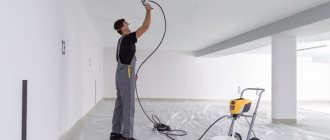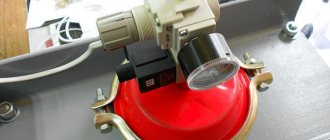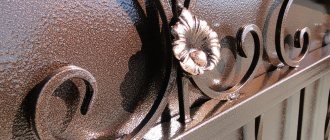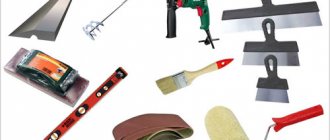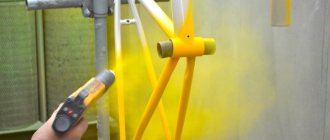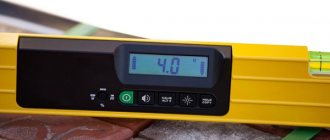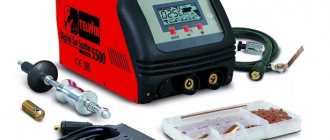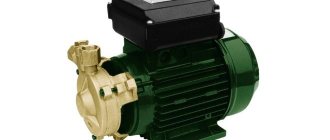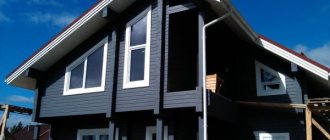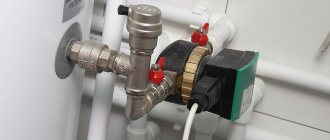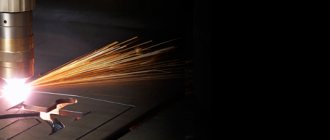The quality of the surface after painting does not always depend on the professionalism of the specialist. The tool used can also influence the result to a large extent. The correct choice of equipment can significantly simplify the work and allow a less qualified specialist to carry out painting work. But sometimes an incorrectly selected tool can seriously complicate the work of painting the surface.
One of the most popular devices used for painting is a pneumatic spray gun. His choice is fraught with certain difficulties, which can be avoided if you know a number of important points.
Design and principle of operation
Before you go shopping for a pneumatic paint sprayer, it's a good idea to become familiar with its design. In appearance, this tool resembles a metal gun, which has a flexible hose leading to the compressor. Each such device is equipped with a paint container, a conical nozzle and a sealing needle. Additionally, it has adjusting screws.
This equipment has a fairly simple operating principle. The main working element is the compressor, which pumps air to the pressure specified in the settings. When the trigger is pulled, the valve opens and compressed air is directed into the nozzle. Due to the pressure difference, the paint is forced out of the tank and sprayed into tiny particles. As a result, a stream of “color mist” is supplied from the spray gun nozzle, which creates a coating. This jet is usually called a torch, which can have a different cross-sectional shape.
Many models of paint sprayers provide the ability to adjust the air flow rate and the spray material. To do this, manufacturers equip them with several nozzles of different diameters.
Ramzec-84 › Blog › Paint gun systems
I’m posting an article... for those who will find it useful in making a choice, for others just to broaden their horizons... All spray guns offered for sale today are divided into the following material spraying systems:
HP (High Pressure)
- high pressure.
HVLP (High Volume Low Pressure)
- high volume, low pressure.
LVLP (Low Volume Low Pressure)
- low volume, low pressure.
LVMP (Low Volume Middle Pressure)
– low volume medium pressure.
RP (Reduced Pressure)
- low pressure.
MP (Middle Pressure)
- average pressure.
HTE (High Transfer Efficiency)
– High transfer efficiency.
Below, we will consider in more detail the paint transfer systems most often used by painters for garage and general car repair painting.
HP system spray guns
Perhaps they occupy first place among garage painters and this is a paint spraying system that has already become a classic. The spray guns of this system spray the material at high pressure at the outlet of the spray head with components of the order of 1.2 - 1.5 atm.
The recommended pressure at the inlet of such a spray gun has a wide range and is 2.5 – 5 atm. Air consumption when working with such paint sprayers can be considered quite low, from 100 to 300 liters per minute.
Wide torch, resulting in uniform application of material (paint, varnish).
High speed of application of paint material.
The disadvantages include the low percentage of paint transfer, up to approximately 45%, i.e. 65% of the paint and varnish you bought simply flies into the air by ricocheting off the surface, turning into fog and settling, coloring everything around.
Also, due to high pressure, turbulence is created in the air, which leads to high contamination of the painted surface, which subsequently leads to inevitable grinding and polishing of the surface after painting.
HVLP spray guns
They were invented by designers in the 80s of the last century for the sake of environmental protection. Their design is designed in such a way that, thanks to the special structure of the air channels of the gun, paint is sprayed at a low outlet pressure (approximately 0.7 atm) and a sufficiently high inlet pressure of 2.5-3 atm. Due to this sprayer design, the developers achieved the highest material transfer, over 70%. (The official requirement for manufacturers of such equipment is a material transfer of at least 65%) And as you can understand, only 35-20% of the paint flies into the air, accordingly, this spraying system is not only economical, but also more environmentally friendly.
Such savings are achieved by the fact that at the exit from the nozzle the paint drops have a very low speed, which means less ricochet and less fog formation. Therefore, the material should be applied with such a spray gun quite close to the surface to be painted, approximately 12 - 15 cm.
High savings in materials.
Virtually no pollination.
No swirls, no debris.
High compressed air consumption, from 360 liters per minute and above, therefore, a powerful compressor with high performance is needed.
Increased diameter of the air duct.
Installation of additional filters to clean the air from moisture and oil, since the compressor works, as they say, “to the fullest”, distilling a mass of air.
High professionalism is required from the painter. Hold your hand a little while wiring, and you are guaranteed to have some leaks. Due to the close distance of the spray gun to the surface to be painted, it is inconvenient to paint distant places that are difficult to reach. RP (Reduced Pressure) series spray gun
is an improved high pressure technology, combines excellent painting speed. RP series spray guns appeared in the nineties of the last century, this was due to the fact that HVLP spray guns did not have high pressure at the outlet of the nozzle, and therefore were limited in their use. In this regard, there was a need for a new spray gun, which in turn would have the pressure of traditional spray guns and the advantages of HVLP series spray guns. It is suitable for the application of all types of paints, especially those with reduced solvent content such as HS varnishes. Fast work is ensured thanks to a wide torch and a large amount of flowing material. The optimized high pressure of the RP series spray gun allows for the finest atomization and finish. In addition, compared to HVLP spray guns, less compressed air is required for spraying, which reduces the cost of purchasing a compressor with a relatively low air output.
LVLP system spray guns
A fairly recent development and is a kind of compromise between HVLP and HP. The designers have tried to eliminate the disadvantages inherent in the above spray systems, so LVLP is the most promising today. Having a pressure of 0.7-1.2 atm at the outlet, and about 1.5-2.0 atm at the inlet, we get a high paint transfer of 65% with a relatively low gluttony of compressed air of 150-350 liters. Increasing the distance from the gun to the surface when applying paint-varnish by 5-10 cm compared to HVLP makes it easier to paint hard-to-reach places.
Low air consumption.
High transfer of materials to the painted surface.
Low sensitivity to pressure changes.
Not discovered yet. LVLP (Low Volume Low Pressure) spray guns have the advantages of the above options and are practically free of their disadvantages. In my opinion, this is the best option for professional car painting. With a high percentage of paint transfer, a very powerful compressor is not needed. To work with such a spray gun, you need to have a certain skill, otherwise you are guaranteed to get smudges. The remaining spray systems (LVMP, MP, HTE and others) are a symbiosis of the above, do not have any special design features and differ only in the original name given to them by the manufacturer, so there is probably no point in studying them further.
Source: www.drive2.ru
Advantages and disadvantages of the product
A pneumatic sprayer has a number of positive qualities:
- possibility of use in premises that do not allow painting work using electrical equipment due to the danger of fire or explosion;
- high quality and efficiency of work;
- efficiency. Devices of this type allow you to minimize paint consumption;
- high strength. These devices fail on very rare occasions;
- operational safety;
- can be used in rooms with a predominance of high humidity;
- simplicity of design, maintenance and use;
- overload resistance;
- the presence of a sealed housing, which minimizes the risk of dust or debris getting into the paint and knocking down the spray nozzle.
This device also has a number of disadvantages:
- the need for compressed air, so it can only be used in conjunction with a compressor;
- low level of efficiency. The spray gun requires a connection to the electrical network, since the compressor cannot work independently.
Paint application technology
The procedure must be carried out at +5...+35°C and relative humidity no more than 80%. Spray guns only work with materials whose ignition temperature is not lower than 210°C.
To protect the respiratory system when painting, you need respirators, and to prevent chemical liquids from getting on your skin and eyes, you need gloves and safety glasses. The work room must be equipped with supply and exhaust ventilation. The surface ready for painting - clean, dry, grease-free, smooth - is additionally treated with sandpaper (P240-P600), after which the dust is removed.
Before use, filter the paint and dilute it according to the instructions, otherwise feeding into the nozzle will be difficult. Work can be carried out indoors or outdoors, under different conditions. It should be taken into account that the viscosity of a substance changes with increasing and decreasing temperature and air humidity. A viscometer is used to measure the viscosity of the paint; if necessary, the material is diluted.
Some technologies, in particular those working with viscous substances in an auto repair shop, require constant inlet pressure. Therefore, even if there is a gearbox, in such cases it is recommended to install an additional device (WESTER 816-004 or 003) that prevents loss of pressure in the air line.
Before painting the main surface, you need to make several test movements. To prevent drips, spraying begins with a small amount of paint. First of all, cover the outer side of the surface to be treated, corners, decorative elements, then the entire remaining area.
Spraying is carried out evenly from the edge to the center of the surface, gradually moving to cross movements. Before applying the second layer, wait until the paint has time to dry.
Variety of types of devices
If you are planning to carry out renovations in your apartment, we recommend purchasing a pneumatic spray gun for painting work. These devices differ from each other in different characteristics, including the spraying method:
- Traditional . Their operation is based on the principle of using high pressure compressed air. Paint sprayers of this type are able to provide high quality work and uniform coating. But experts do not recommend using them for painting structures with complex surface configurations. This is due to the high level of waste when using such a spray gun.
- With low compressed air pressure . For such devices it does not exceed 0.7 atmospheres. Accordingly, the use of such paint sprayers ensures lower consumption of the starting material. But due to low pressure, the coating is less uniform. In addition, the time required for painting increases, which negatively affects the condition of the compressor.
- With medium compressed air pressure . These are the sprayers that are recommended for most users. They are characterized by low material consumption and provide very good coating quality.
Which spray gun should you choose?
Each type of sprayer has its pros and cons:
- HP allows you to paint evenly and quickly, but due to the formation of a large amount of paint dust in the air, it does not provide ideal painting quality. When applying glossy materials, you will have to polish the surface after drying. To work with such a spray gun you will need good personal protective equipment.
Advice! HP is the best option for a novice craftsman and for spraying inexpensive materials. This is a simple and inexpensive spray gun for home use.
- HVLP paints better and uses material more economically, but requires an expensive, powerful compressor and clean air.
- LVLP gives excellent painting quality - with such equipment you can do without polishing the painted surface. But its use requires a certain skill from the operator. The torch of this sprayer is narrow, and the material is supplied very quickly. Therefore, LVLP requires a steady hand: the spray gun must be held close to the surface, moved quickly and evenly so that smudges do not form. This sprayer is expensive and is suitable for painting furniture, doors, and car body parts.
Compressor Features
The main part of the spray gun design. In its absence, staining cannot be performed. Therefore, it is necessary to approach the choice of compressor with special care.
Its main characteristic is power. For domestic use, you can purchase a device with a power of 1.2 kW. You should also pay attention to the receiver, the optimal volume of which is considered to be 25-50 liters.
Air compression force is also important for a compressor. The standard pressure is 8 bar.
The quality of the spray gun also depends on the performance of the compressor. The user needs to decide how many liters of air the device should produce per minute of working time. This parameter may differ for different sprayer models.
It is advisable that the compressor have a protection system against overload and voltage surges. Therefore, it is best to purchase products equipped with automatic shutdown.
sergius41 › Blog › Spray gun with high air flow and weak compressor. How to paint
Spray gun with high air consumption and weak compressor. How to paint. And in this case, you can understand why the mysterious third lower adjustment screw on the body of the spray gun is needed. The air supply limitation screw on the spray gun allows you to configure the spray gun with a high flow rate for painting from a low-power compressor. But the spray gun settings will still have to be reduced. Of course, a large spray gun requires a powerful compressor. But what to do if there is no such compressor yet. Then we regulate, or rather limit, the air supply to the spray gun. A weak compressor with a capacity of 206 l/min in this case begins to cope with a spray gun whose air flow rate is more than 300 liters per minute.
Device selection criteria
When choosing a spray gun for use at home, the owner needs to focus on his own needs. To do this, you need to understand what functions it will need. And only after that should you move on to studying the characteristics of the model that interests you.
The key parameters of the spray gun that should be considered when choosing are the following:
- Pressure . Most compressors can compress air up to 6-8 bar. With this indicator, the motor automatically turns on and pumps in air. But there are devices that can maintain operating pressure at 10 bar.
- Productivity . One of the main characteristics on which the quality of the work performed depends. It should be understood that the performance of the tool is not affected in any way by the volume of compressed air that the device can produce in one minute of working time. The performance of a particular model can only be determined in practice by creating special conditions for it. Therefore, this parameter will be different for each device.
- Spray adjustment . This feature can be very useful if you are going to paint the ceiling. With its help, you can change several actions without taking breaks during work:
- output air indicators;
- torch shape;
- needle stroke.
Tool parameter settings before use
Setting up a spray gun for beginners is one of the most difficult moments when using it for the first time. You should start by testing the parts for integrity. In this case, you need to fill the device three-quarters, and the engine turns on.
After connecting the hose to the gun, look at the quality of fastening the bolts and nuts. When you are convinced that the paintwork is not leaking and the work is proceeding uninterruptedly, you can proceed directly to painting the base.
You need to adjust the operating parameters of the tool using the regulator screw. The screw located at the bottom of the pistol part rotates. In one direction it increases the volume of air flow, in the other it decreases. The level of material supply is also regulated.
Turning the screw clockwise results in a circular spray pattern, while counterclockwise produces an ellipse.
You need to adjust the operating parameters of the tool using the regulator screw.
Popular manufacturers
Stores offer many models of pneumatic spray guns from different manufacturers. And each of the presented options has its own competitive advantages. Some products focus on quality and brand recognition, while others focus on cost. In order not to get confused in this variety of offers and to choose a suitable spray gun for home use, let’s take a closer look at the most famous brands.
Bosch paint sprayers
The company's products are widely represented in many different industries. The concern specializes in the manufacture of a wide range of tools, including pneumatic spray guns. The most popular among them are:
- PFS 55 . It has a common housing with the compressor and is characterized by simplicity, versatility and mobility.
- PFS 65 . In this model, the compressor is made as a separate unit, which allows it to be used to perform more complex work.
- PFS 105 E. It has a good power reserve and is equipped with a remote compressor.
Walcom Products
This brand belongs to the famous Italian company Walmec. The company's products are known throughout the world, including due to their impeccable European quality. The following models can be distinguished in the line of this manufacturer:
- Genesi S HVLP . A pneumatic device for professionals, which has a corresponding price.
- Genesi S GEO . The model is focused on carrying out work of a high degree of complexity and is intended for professional use.
- Slim SP HVLP . It has a simpler device, but is also suitable for professionals. Has an external mechanism for feeding the sprayed material.
- Slim S. At a low cost, the model is of high quality. It is aimed more at amateurs and can be used for small amounts of work.
Wagner range
Over the past years, the company has occupied one of the leading positions in this area. Specializes in the production of equipment for both amateurs and professionals. The company's products are very easy to use and have a well-thought-out design.
The following models are of greatest interest:
- Projectpro117. A professional-oriented station with an appropriate price. The package includes a spray gun, a compressor and a set of filters.
- W665 WallPerfect. A more affordable option that can be used not only by professionals, but also by amateurs.
- W550. One of the most affordable solutions, it is characterized by high operational efficiency and quality of execution.
Devices from the manufacturer Gav
The company is one of the oldest manufacturers of pneumatic tools in Italy. Along with inexpensive products, it also produces solutions for professional use. Among them are:
- Record 220 Eco. Affordable, high quality equipment. Supplied without compressor, which must be purchased separately.
- 162 A. A manual model of a paint sprayer is included in the list of the most affordable tools of this type.
- Record 2000 Eco. A tool designed for professional and semi-professional use.
Nozzle diameter
Nozzles for spray guns are produced in the form of replaceable nozzles. The nozzle diameter affects the size of the material particles ejected from the nozzle. The finer the nozzle opening, the finer the paint is sprayed. For thick, viscous compositions, larger diameter nozzles are needed. Nozzles should be selected for a specific material.
| Nozzle diameter, mm | Spray material |
| 1,7–2,0 | Liquid putty, thick, viscous paint |
| 1,5–1,7 | Acrylic primers |
| 1,4–1,5 | Varnishes, acrylic paints |
| 1,2–1,3 | Base coats (paints with a “metallic” effect, etc.) |
If the spray gun is not equipped with a replaceable nozzle, it is worth choosing the most universal diameter that is suitable for all planned work.
The diameter of the spray gun nozzle affects the type of material being sprayed.
On a note! The most popular nozzles are with an average diameter (1.3–1.7 mm). For example, a sprayer with a 1.5 mm nozzle is best for home repairs, and a 1.4 mm nozzle for painting a car.
If the spray gun is of high quality, it is usually equipped with a set of nozzles with a diameter of 1–3 mm. Often the kit also includes attachments that give different torch shapes.
